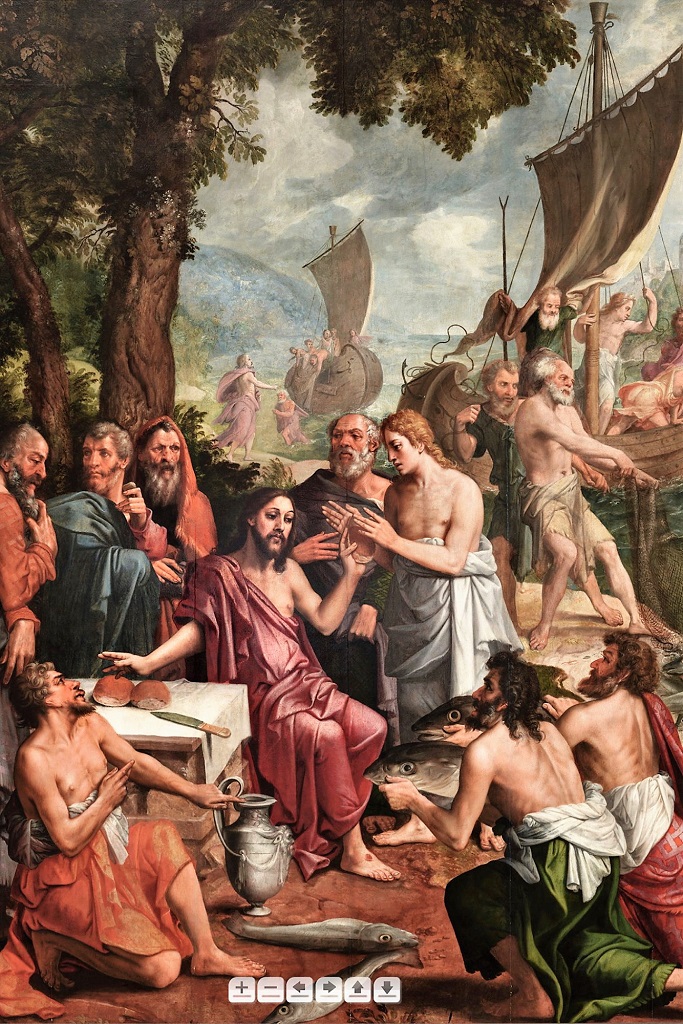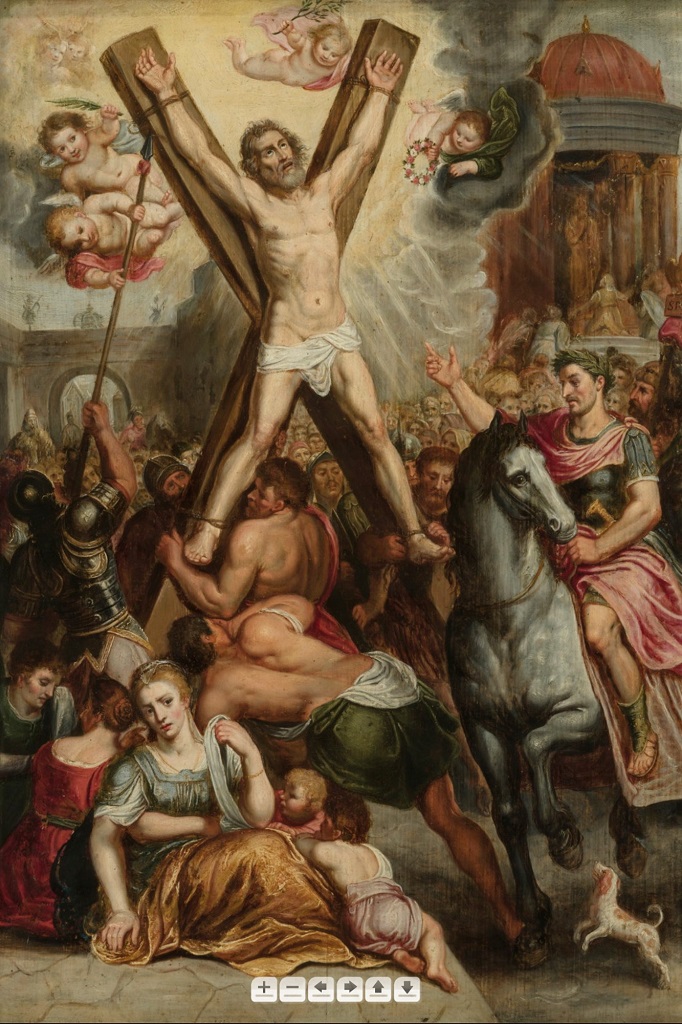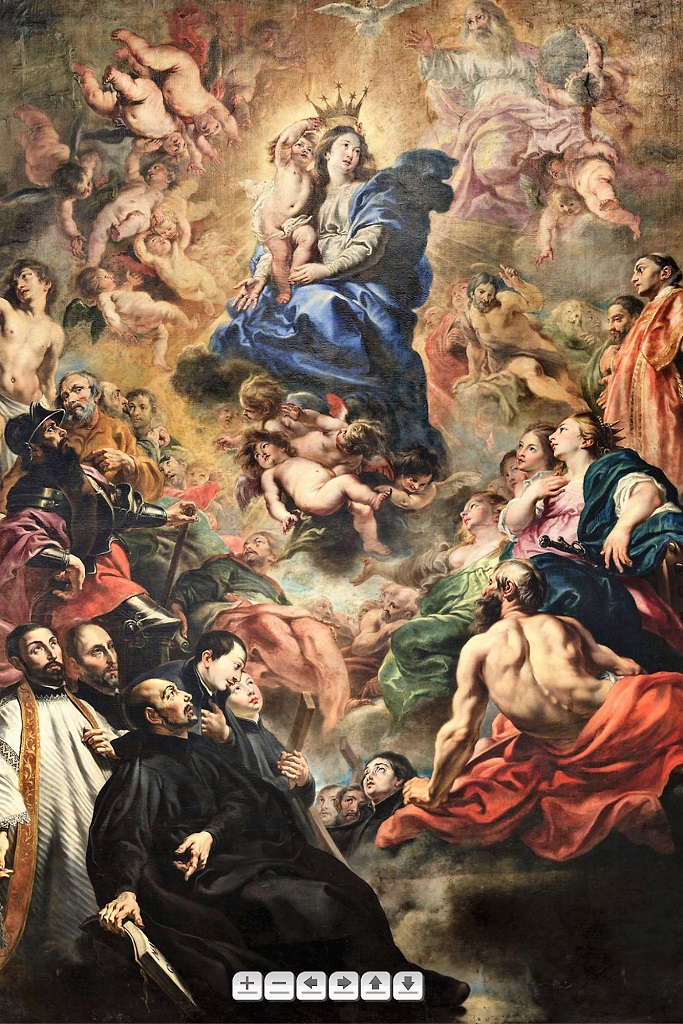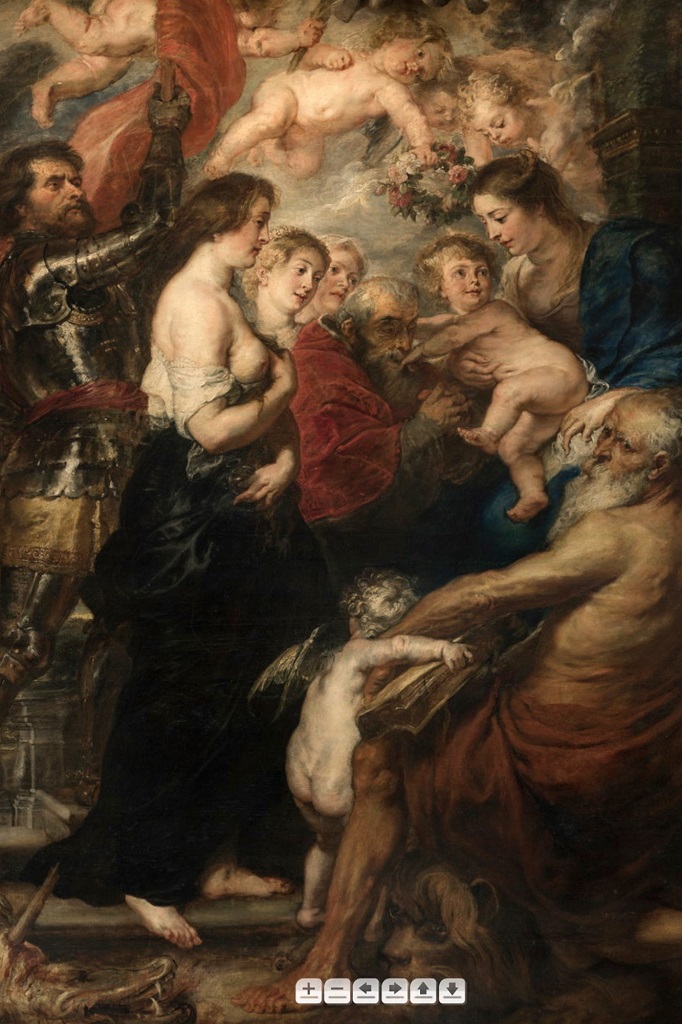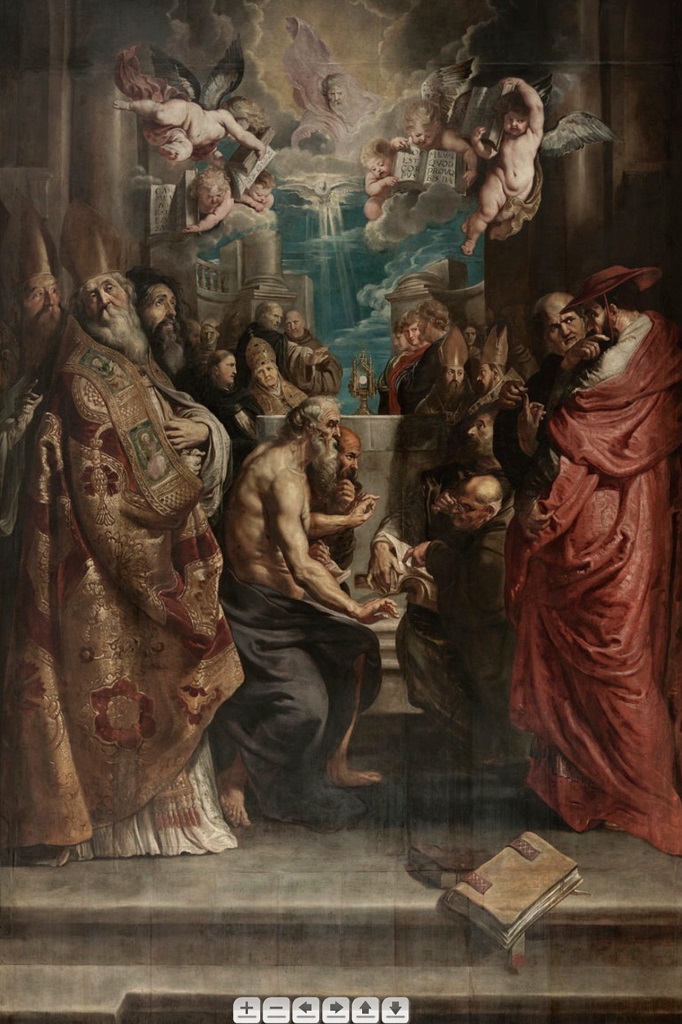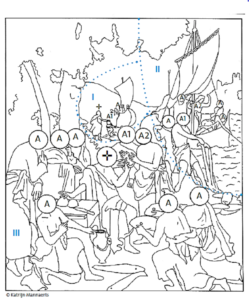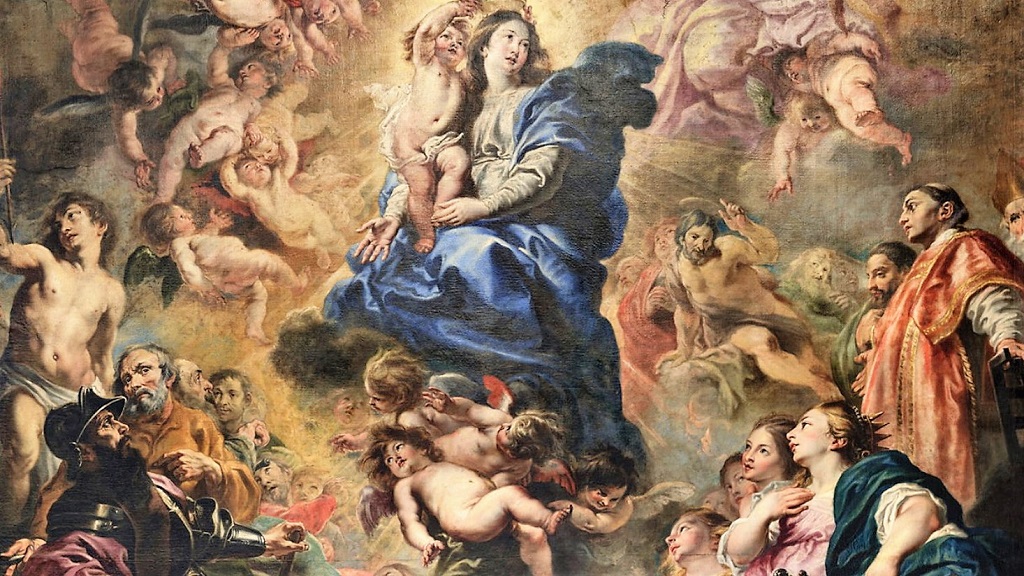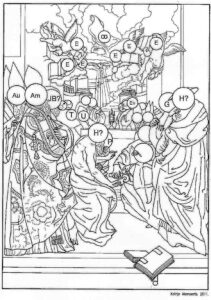Gigapixel photo gallery
In 2021, Gilles Alonso, a French photographer living in Antwerp, contacted TOPA.
He specialises in “Very High Resolution” photography also known as Gigapixel.
With this technology, an image can be enlarged almost endlessly.
In this way, a painting reveals details that you would never see in a church or museum.
In other words, you look through the eyes of the painter!
He offered to photograph one painting in each of Antwerp’s five tourist churches.
The result is amazing!
The following paintings can already be admired by clicking on them.
You can zoom in and out as well as move around using the icons at the bottom or the mouse.
In the Our lady’s Cathedral: “The Miraculous Catch” by Hans van Elburcht
In the St. Andrew’s church: the modello for “The Martyrdom of St. Andrew” by Otto Van Veen
In the St. Charles Borromeo’s Church: “The Coronation of Mary” by Cornelis Schut
In the St. James’s Church: “Madonna and Child” by Peter Paul Rubens
In the St. Paul’s church: the “Dispute over the Blessed Sacrament” by Peter Paul Rubens
Below is a detailed description of each of these paintings.
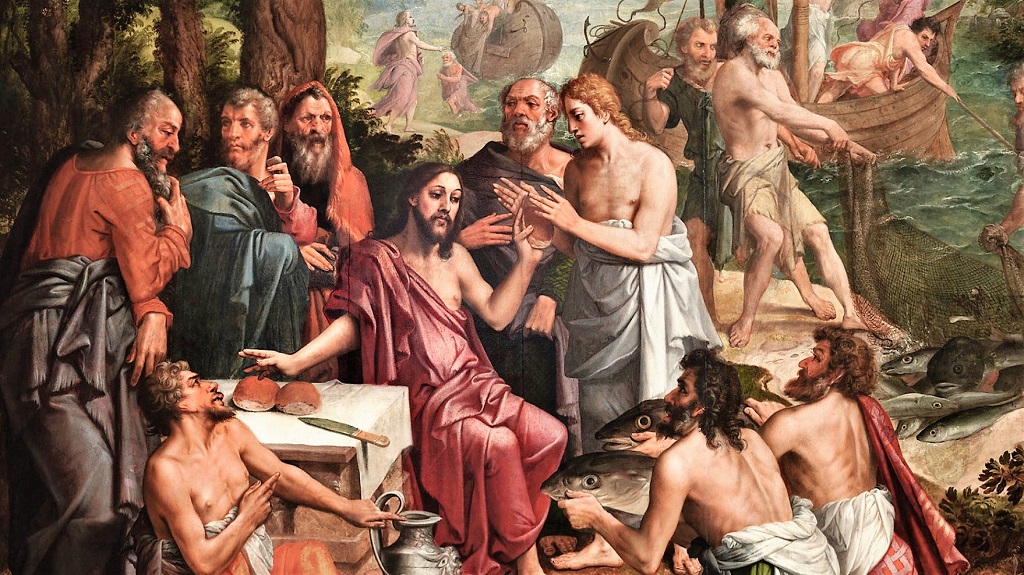 The fishmongers’ altarpiecePainted and/or carved back wall of an altar placed against a wall or pillar. Below the retable there is sometimes a predella. by Hans van Elburcht, ca. 1560, reflects the devotion for their patron saints: the apostle-fisherman par excellence, Peter, the most important one, is in the central panel and on the left panel of the predellaThe base of an altarpiece. Like the altarpiece, the predella may be painted or sculpted.; the apostles Philip and James the Less are on the wings.
The fishmongers’ altarpiecePainted and/or carved back wall of an altar placed against a wall or pillar. Below the retable there is sometimes a predella. by Hans van Elburcht, ca. 1560, reflects the devotion for their patron saints: the apostle-fisherman par excellence, Peter, the most important one, is in the central panel and on the left panel of the predellaThe base of an altarpiece. Like the altarpiece, the predella may be painted or sculpted.; the apostles Philip and James the Less are on the wings.
The main scene in the foreground was inspired by a print from 1556 by Pieter van der Heyden, which in its turn goes back to a work by Lambert Lombard. Because it was adapted to a portico altarThe altar is the central piece of furniture used in the Eucharist. Originally, an altar used to be a sacrificial table. This fits in with the theological view that Jesus sacrificed himself, through his death on the cross, to redeem mankind, as symbolically depicted in the painting “The Adoration of the Lamb” by the Van Eyck brothers. In modern times the altar is often described as “the table of the Lord”. Here the altar refers to the table at which Jesus and his disciples were seated at the institution of the Eucharist during the Last Supper. Just as Jesus and his disciples did then, the priest and the faithful gather around this table with bread and wine. the triptych was made smaller, probably in 1621, when the fishmongers’ altar was moved to the western pillar of the central naveThe space between the two central series of pillars of the nave.. Unfortunately we do not know anymore what the complete central scene looked like originally.
The central panel shows in three acts successive scenes from the story of the miraculous catch of fish (John 21:1-14). The story is to be read from the background top left [I] to the middle ground centre right (II) and then back to the foreground on the left [III]
[I] On the initiative of Peter six apostles join him to go fishing on Lake Tiberias, but they do not catch anything. At the apparition of the Risen Christ (✛) on the bank there is a miraculous catch of fish. While the other six apostles do everything they can to hoist the full nets aboard, Peter (A1) wades through the water to Christ.
[III] ‘The other disciples came in the boat’, ‘dragging the net with the fish’. At Jesus’s demand for some of the (miraculous) fish that they have just caught Peter (A1) drags the rich catch ashore.
[III] In the foreground the emphasis is on the supply of the ‘large fish’, which Jesus (✛) gave them in His turn together with the bread. Peter (A1), once again as (second) main character, has knelt in front of Jesus, together with young John (A2) with the blond hair.
The wings focus on the two other patron saints of the guild. The left wing shows the baptismThrough this sacrament, a person becomes a member of the Church community of faith. The core of the event is a ritual washing, which is usually limited to sprinkling the head with water. Traditionally baptism is administered by a priest, but nowadays it is often also done by a deacon. of the Ethiopian eunuch (alias ‘the Moor’) by Philip (Acts 8:26-40) (Rotterdam, Boijmans Van Beuningen Museum). On the right we see the martyr’s death of James the Less (Saint-Ghislain, ConventComplex of buildings in which members of a religious order live together. They follow the rule of their founder. The oldest monastic orders are the Carthusians, Dominicans, Franciscans, and Augustinians [and their female counterparts]. Note: Benedictines, Premonstratensians, and Cistercians [and their female counterparts] live in abbeys; Jesuits in houses. of the Sisters of Mercy).
In the last quarter of the 16th century, presumably after the restoration of Catholic worship in 1585, the two panels of the predella were added, by an anonymous artist probably from the surroundings of Ambrose Francken. Here Jesus invites fishermen to follow him: they will be the first apostles. On the left panel (iconographically right) with The calling of Peter at the miraculous catch of fish (Lk. 5:1-11), one can see how in the background fish is being supplied on the quays. Its location reminds of the Antwerp Wharf with the fish market in front of the Steen. On the right panel another pair of brother-fishermen is shown at The calling of James the Greater and John (Mth. 4:21-22, Mk. 1:19-20). They leave their fatherPriest who is a member of a religious order. Zebedee behind in the boat. Due to the adaptation to the new altar James in grisaille disappeared from one outer wing and Philip on the other was severely damaged.
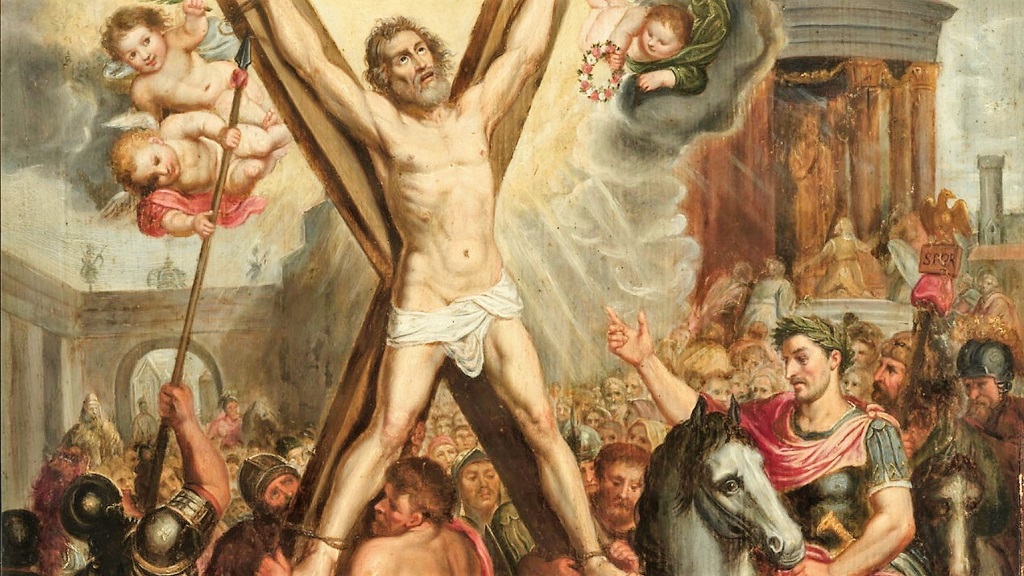 The modello hangs in the corridor of the museum. The original hangs on the south side of the sanctuary.
The modello hangs in the corridor of the museum. The original hangs on the south side of the sanctuary.
While the posture and gestures of some of the painting’s figures might suggest that this scene depicts ‘the crucifixion of Andrew’ – as the painting has often mistakenly been called – this image in fact depicts Andrew’s death, precisely at the time when he was to be released from the cross. The image originated from the Legenda Aurea, by the Dominican monkA male member of a monastic order who concentrates on a life of balance between prayer and work in the seclusion of a monastery or abbey. Jacobus de Varagine (1228-1298). In the Greek town of Patras, Maximilla had been willingly converted to Christianity by Andrew.
Wife to the Roman proconsul Ageas, a cruel and pagan man, Maximilla began to distance herself from Ageas, both literally and spiritually. In consequence, and completely oblivious to any criticism, her husband had Andrew crucified. While tied to the cross, Andrew kept on preaching tirelessly to the growing crowd for two more days. Alarmed by the massive protest against his unjust ruling, the proconsul decreed that the disciple should be released from the cross.
- Left in the foreground (iconographically to the right), Maximilla is seated close to the cross. Filled with sadness about Andrew’s suffering, she looks directly at the viewer, while she wipes away her tears with a piece of cloth in her left hand. Two children lean against her, as does one of the two women in conversation, who has her arm around Maximilla’s waist in an effort to comfort her.
- The crowd that has come to listen to Andrew preaching from the cross gather around both cross and executioners, and cry their support to the latter , who are freeing Andrew from the cross.
- In the foreground (ichnographically to the left), proconsul Ageas is seated on a grey horse. His extended right arm does not allude to his initial command, to crucify Andrew, but instead refers to his second command, to undo Andrew’s martyrdom. The standard with the Roman eagle emphasizes Ageas’s authority.
- Instead of erecting the cross, the soldiers and executioners carry out the proconsul’s new command. Raising his lance, the armoured soldier to the left is about to cut loose the rope at Andrew’s right hand, as does the executioner in blue loincloth with the ropes at the saint’s left foot. A soldier and two servants hope to pull down the cross.
- About to succumb yet looking forward to his full encounter with God, Andrew lifts his eyes to heaven. High on the cross, raised above the human massThe liturgical celebration in which the Eucharist is central. It consists of two main parts: the Liturgy of the Word and the Liturgy of the Eucharist. The main parts of the Liturgy of the Word are the prayers for mercy, the Bible readings, and the homily. The Liturgy of the Eucharist begins with the offertory, whereby bread and wine are placed on the altar. This is followed by the Eucharistic Prayer, during which the praise of God is sung, and the consecration takes place. Fixed elements are also the praying of the Our Father and a wish for peace, and so one can symbolically sit down at the table with Jesus during Communion. Mass ends with a mission (the Latin missa, from which ‘Mass’ has been derived): the instruction to go out into the world in the same spirit., the saintThis is a title that the Church bestows on a deceased person who has lived a particularly righteous and faithful life. In the Roman Catholic and Orthodox Church, saints may be venerated (not worshipped). Several saints are also martyrs. already appears to partake in his mediating role between God and humanity. As legend has it, Andrew answers that God is expecting him, and then dies, surrounded by heavenly light – just before the soldiers cut the ropes.
- Heavenly light, a sign of divine assistance, surrounds the white incarnate of Andrew’s body. The anticipation of heavenly joy seemingly makes Andrew forget the pain of martyrdom. The martyr’s delight and surrender in seeing the heavenly light is in stark contrast to the bystanders below, who have been overly preoccupied with earthly torture.
- Three angels, one with a palm and two with a laurel wreath (a laurel crown and a red-and-white flower garland), symbolically offer Andrew the heavenly reward. Thwarting the soldier in armour carrying the lance, a fourth angel even ensures that Andrew won’t be denied the honour of martyrdom! The saint’s exaltation in heavenly glory was a typical motif of the Counter-Reformation, which strongly promoted the cult of saints. By emphasizing how the saints suffered to bear witness of their faith, these were put forward as vigorous examples of ‘good works’, the importance of which was denied by Lutherans and Calvinists. As such, the cross – that instrument of torture occupying almost two thirds of the entire painting – here appears as a trophy prefiguring victory.
In the background to the right, a round small temple can be seen, with a statue of the idol worshipped there. Left in the background, a gatehouse is topped by two Roman cuirasses with lances. Below right, a small dog frolics happily.
Several authors of the Ancien Régime refer to this work of art, which is considered one of Schut’s most important, simply as an Assumption of MaryThis feast – on August 15 – plays an important role in the veneration of Mary as the Mother of God. As the most important saint, it is obvious to Christians that upon her death she was immediately received into the heavenly paradise. In the Eastern Churches, this is called the feast of “the Falling Asleep of the Mother of God”, i.e. her death, which immediately means a heavenly rebirth. In Antwerp they also celebrate Mother’s Day on that day. Some people also call this the Ascension of Mary, which is wrong. Unlike Jesus, who as God Himself could return to the place where He is at home, Mary could only be taken up to heaven through God the Father and Jesus.. This tableau has always remained in the church and is still set up there during certain periods of the liturgical year. According to F. Peeters, this work never left its original architectural framework because it did not find a buyer when the Jesuit property was sold. The work, which is Rubenesque in composition and colour, depicts Our Lady sitting high up in the clouds with a nimbus around her head surrounded by a glow of light. The Child Jesus is standing on her right knee and, in a lively movement, puts a crown on her head with his two hands. Meanwhile, above in the right-hand corner, God the Father is watching this event. Just above the crowned head of the Virgin, the Holy SpiritThe active power of God in people. It inspires people to make God present in the world. Jesus was ‘filled with the Holy Spirit’ and thus showed in his speech and actions what God is like. People who allow the Holy Spirit to work in them also speak and act like God and Jesus at those moments. See also ‘Pentecost’. is depicted in the form of a flying dove. Mary is staring at God the Father, who stretches out his right arm above her in sign of welcome and blessing. On the other side, he is clasping a globe that a flying angel is carrying in front of him. The central scene is first surrounded by several groups of hovering angels. Then there is a series of saints surrounding the glorious Virgin. On the far right, St. Laurentius is depicted, dressed in a red deacon’s vestment. The figure behind this upright martyrSomeone who refused to renounce his/her faith and was therefore killed. Many martyrs are also saints., on the other hand, is not recognisable. In front of them, several virgins are depicted, including St. Catherine and St. Agnes, as well as St. Jerome on a large cloud, with his naked back turned towards the spectators. At the very bottom are the three Jesuit martyrs of Japan, of whom only the heads are visible. Further to the left, St. Ignatius is kneeling. He points with his left arm to an open book, which he holds against the frame with his other hand. He is accompanied by St.-Aloysius of Gonzaga and St.-Stanislas Kostka. More to the left, St. Francis Xavier stands as the only one of all the Jesuits depicted here in priestly garb – the others wear the black Jesuit cassockA long, usually black, garment that reaches down to the feet and is closed at the front from bottom to top with small buttons. Synonym: soutane.. Behind him one notices the face of St. Francis Borgia. Above this group of “own order saints”, St.-Joris stands proudly upright in his armour, with a helmet on his head and a sword vest in his protruding left hand. Diagonally below him, St. John the Baptist floats. Next to St. George stands St. Joseph, groom of the heavenly Virgin. He, however, turns his head away from this mysterious event. Behind him one sees the apostles Peter and Paul. Finally, the almost naked, heavily built body of Saint Sebastian appears, staring at the wounds on his raised right arm. The circle is closed by a whole group of frolicking putti. Without all these figures forming a perfect unity, they certainly contribute to the glory of this joyful mystery.
The ‘Ascension’ of Mary reaches its final destination here, as she is taken up by the Holy Trinity. However, it is only the Son, as a little Child, who crowns his mother as heavenly queen. The question can be raised whether this queenship was not further specified. After all, we notice that all sorts of categories of chosen creatures are depicted here, each of which has Mary as its queen: the virgins (St. Catherine and St. Agnes), the apostles (Peter and Paul), the martyrs (St. Lawrence, St. Sebastian, as well as the three Japanese martyrs (St. Peter and St. Paul) and the Virgin Mary. The saints in general (with in the foreground (literally!) those of the Jesuit order, as well as St. Joseph, St. John the Baptist, St. Jerome, and St. George), some of whom also continue as confessors, and then there are the numerous angels. In this way we could perhaps arrive at a representation of the Holy Virgin with all her royal titles, as they appear, for example, in the litany of Loreto. However, we will not get that far here, due to the lack of, among others, the patriarchs. It is therefore sufficient to call her “Queen of Saints”, as was done once more by an anonymous author in the 9th century, who mentions this work as the only “remarkable painting” of the entire church.
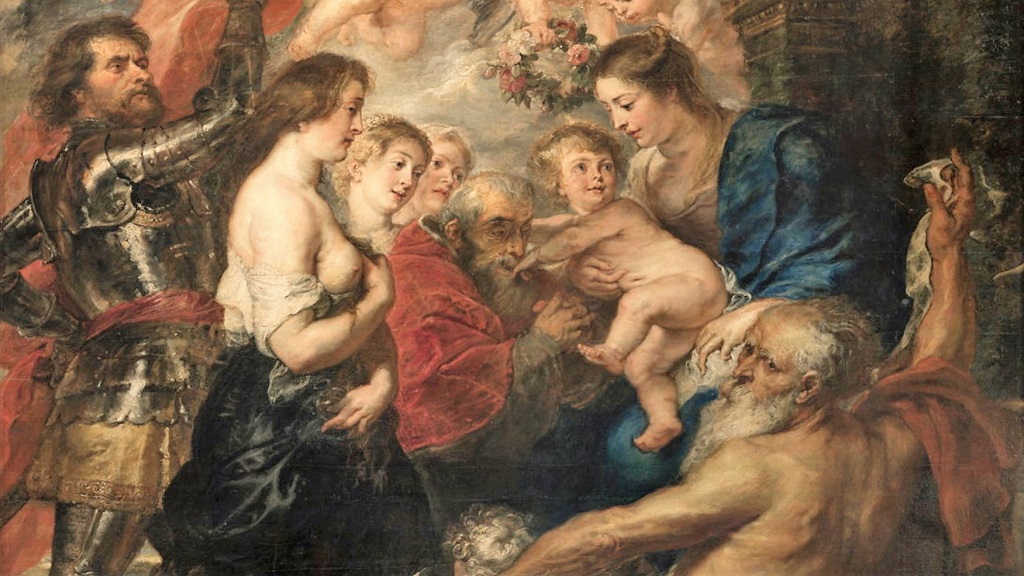 This work is on the altar of the Rubens Chapel
This work is on the altar of the Rubens Chapel
A small church that is not a parish church. It may be part of a larger entity such as a hospital, school, or an alms-house, or it may stand alone.
An enclosed part of a church with its own altar.
.
This painting was once commissioned to Rubens, but for some unknown reason was never delivered to his patron. Presumably it is a votive painting, which the unknown bishopPriest in charge of a diocese. See also ‘archbishop’. ordered to express his devotion to Mary. Thus Pieter Pauwel could give it a new purpose, which he only did on his deathbed in the new prospect of his own burial chapel. In Romanticism, this was wrongly interpreted as if Rubens had designed this work as his personal memorial piece, and people were tempted to identify as many characters as possible in the painting as members of Rubens’s family, including the master. In any case, Rubens’ choice of this painting expresses his personal devotion to the Virgin.
At the time of Rubens’ death, the abbot of Saint Germain in Harelbeke profoundly testified: “He left us to see the original of several beautiful paintings he had left us”. In that case, this painting already gives us a pleasant glimpse of that heavenly original…
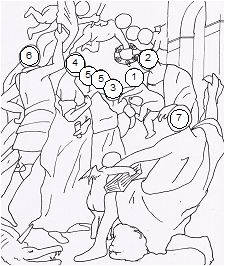
Mary (Ma) is sitting on a marble bench in front of a portico covered with foliage, while she is crowned by several cherubs with a garland of flowers. She herself functions as a throne for her Son. The roguish Jesus Child (JC) on her lap looks up smilingly at his mother and playfully stretches out his hands to the unknown bishop (B), who kneels down.
Behind him stands Mary Magdalene (MM), recognisable by the loose hair, the bare chest and shoulder, and the balsam jar in her hand. She is accompanied by 2 holy women.
On the far left, Saint George (G), in full armour and with a red banner in his hand, approaches triumphantly, with the speared carcass of the vanquished dragon at his feet.
On the right, the ascetic church father Saint Jerome (H), dressed only with a cardinalIn the Roman Catholic Church, a cardinal is a member of the pope’s council and thus he has an important advisory role. Up to the age of eighty, the cardinals also elect the new pope. Most cardinals are also bishops, but this is not a requirement. red drapery around the loins, kneels on his attributed lion. With difficulty, supported by a frisky angel, he holds a heavy bundle of folios in his lap: the ‘Vulgate’, i.e. the Bible that he translated into the Latin vernacular. In his raised right arm, he unfolds a banderole. Looking back, he seeks eye contact with the viewer, hoping to draw you into the intimacy of this ‘conversation with the saints’.
In the 19th century, a copy was made by the Antwerp artist Niklaas Delin. During the World War, this was used instead of the original: one could not be too careful or too cunning!
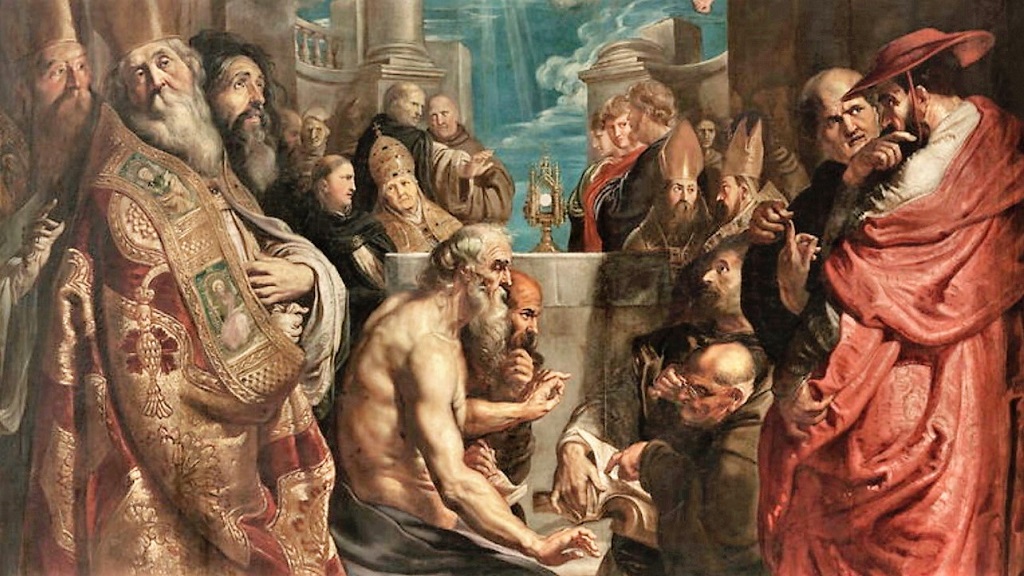 This work is on the Altar of Sacraments.
This work is on the Altar of Sacraments.
Around 1609, the Dominicans ordered this altarpiece and the two predella pieces Moses and Aaron from P.P. Rubens. On the occasion of the new choir stallsA series of seats, usually in wood, along the long sides of the choir. These seats are reserved for those who pray and sing the choir prayers. with two side altars, the Baroque altar of the SacramentIn Christianity, this is a sacred act in which God comes to man. Sacraments mark important moments in human life. In the Catholic Church, there are seven sacraments: baptism, confession, Eucharist, confirmation, anointing of the sick, marriage and ordination. was built by Peter I Verbruggen in 1654-56. For aesthetic (and other?) reasons, the new altar was conceived – according to the contract – as a pendant to the opposing altar of the Virgin Mary, which had been begun four years earlier. In order to fit neatly into this porch altar, Rubens’ panel is enlarged in 1680, especially at the top and bottom, but also slightly in width (to 377 x 246 cm),
In 1616 the painting is called The Reality of the Blessed Sacrament, in other words: The real presence of Christ in the Blessed Sacrament. The Italian term ‘dispute’, by which this painting is known, is not so much to be understood here as a discussion in the event of a difference of opinion, but as a meeting of like-minded Catholics who are looking for arguments to substantiate this belief about the Eucharist. That it is not about a pious adoration of the Sacrament either, but about an intellectual dialogue, characteristic of the scholastic tradition, is made clear by the gesticulations of authoritative scholars and church ministers: “fingers are raised, pointing, emphasising, refuting and summing up the arguments”. The Mannerist, somewhat exaggerated figures are typical of Rubens’ early period.
God the Father (∞), in heavenly soft colours of white, pink and yellow, and the symbolical dove of the Holy Spirit in the upper register underline Jesus’ real presence in the consecratedIn the Roman Catholic Church, the moment when, during the Eucharist, the bread and wine are transformed into the body and blood of Jesus, the so-called transubstantiation, by the pronouncement of the sacramental words. hostA portion of bread made of unleavened wheat flour that, according to Roman Catholic belief, becomes the body of Christ during the Eucharist..
Frolicsome angels (E) hold open the books of the Bible on phrases from the New TestamentPart of the Bible with texts from after the birth of Jesus. This volume holds 4 gospels, the Acts of the Apostles, 14 letters of Paul, 7 apostolic letters and the Book of Revelation (or Apocalypse). that form the foundation for the reality of Jesus’ presence in the EucharistThis is the ritual that is the kernel of Mass, recalling what Jesus did the day before he died on the cross. On the evening of that day, Jesus celebrated the Jewish Passover with his disciples. After the meal, he took bread, broke it and gave it to his disciples, saying, “Take and eat. This is my body.” Then he took the cup of wine, gave it to his disciples and said, “Drink from this. This is my blood.” Then Jesus said, “Do this in remembrance of me.” During the Eucharist, the priest repeats these words while breaking bread [in the form of a host] and holding up the chalice with wine. Through the connection between the broken bread and the “broken” Jesus on the cross, Jesus becomes tangibly present. At the same time, this event reminds us of the mission of every Christian: to be “broken bread” from which others can live., but so that the spectator can read the text from a great distance, only one syllable per line is usually depicted.
Far left: “Caro mea vere est cibus, et sanguis meus vere [est] pot[us]” (= John 6:56; my flesh is real food and my blood is real drink). In the centre left and right this is almost repeated: “Hoc est corpus meum, quod pro vobis datur” (Lk 22:19: This is my body, which is given for you). And on the far right: “accipite et comedite: hoc est corpus meum” (Mt 26:26-27: Take and eat, this is My body).
Moreover, Rubens accentuates this point of faith through the construction and the colours. The lozenge-shaped composition is intended to create a field of tension around the white host, which, encased in a Gothic cylindrical monstranceA decorated glass holder on a base, in which a consecrated host can be placed for worship. In general, there are two types of monstrances: the ray monstrance and the tower monstrance, with the name referring to the shape of the object. The tower monstrance is very similar to the reliquary, which was very popular before the adoration of the Blessed Sacrament became widespread., is not only iconographically the centre of attention, but was also originally, before the enlargement of the panel in 1680, formally the focal point.
The supernatural dimension in the tangible Blessed SacramentThe consecrated host, in which the presence of Jesus Christ is acknowledged. A synonym is ‘the Venerable’. In larger churches a chapel is dedicated to it, usually on the south side of the church. is emphasised by the white host contrasting with the heavenly, blue middle field.
That blue is flanked in the colour composition by the two figures in the foreground: on the left in a golden cope, on the right in cardinal’s red. In this way the sequence of the main colours is neatly triangulated.
At the time of the Counter-Reformation, the Catholic Church wanted to substantiate its view of the Eucharist against the Protestants by appealing to authoritative theologians from the, unsuspected, first centuries of Christianity. Therefore, the four great Western Church Fathers come to the fore. The two bishops, with a golden damask choir dressing gown, on the left, are Ambrose (Am), in front, as the eldest, who turns his head to the second, his pupil Augustine (Au) behind him. On the right, as their full counterpart, are a cardinal, possibly Hieronymus, in a thoughtful pose, and a monk in black Benedictine habit, possibly Pope Gregory I the Great (G?), who was first a monastery founder and abbot. But if there is an old holy man half-naked (H?), then it is St Jerome as a penitent in the desert, who, however, always has a cardinal’s red cloak with him. In that case the cardinal on the right would be the learned Saint Bonaventure. Can the black-haired man behind Ambrose be identified with John the Baptist, who in the desert was not at all concerned about a fine appearance and referred to Christ as the “Lamb of God” (the preeminent address of Jesus, as present in the host of the communionThe consumption of consecrated bread and wine. Usually this is limited to eating the consecrated host.? Behind the half-naked man, the man with the elongated bald head, thoughtfully pulls on his beard and takes notes; he looks a lot like Saint PaulOriginally, he was called Saul, he was a Jew with Roman citizenship and a persecutor of Christians in the period shortly after the death of Jesus. After his conversion, he became the main gospel spreader in what is now Turkey and Greece. He wrote letters to keep in touch with the Christian communities he had founded, and these texts are the oldest ones in the New Testament. Although he never met Jesus, he is called an “apostle”. (P). In that case, his writing refers to the oldest exposition of the Last Supper and to the oldest formulation of the Eucharist, namely in his First Letter to the Corinthians (11:23-39). The pope, with the golden tiaraA triple crown: a headgear consisting of three crowns placed one above the other. It was worn by popes at official, non-liturgical ceremonies from the beginning of the 14 century until 1964, when Pope Paul VI renounced his tiara in order to sell it in favour of development aid., is Urban IV (U), who, through the agency of the Liège beguineMember of a community of unmarried women who led a religious life and lived in a beguinage. Beguines took only two (temporary) vows: obedience (to the Grand Mistress of the beguinage) and purity. As they did not take a vow of poverty, they were allowed to own property. They also had to be self-supporting., St Juliana of Cornillon (), behind him, instituted the feast of the BlessedUsed of a person who has been beatified. Beatification precedes canonisation and means likewise that the Church recognises that this deceased person has lived a particularly righteous and faithful life. Like a saint, he/she may be venerated (not worshipped). Some beatified people are never canonised, usually because they have only a local significance. Sacrament in 1264: ‘Corpus Christi’. He is engaged in a conversation with the great Dominican theologian Thomas Aquinas (T), who can be recognised by the golden bead on his chest. Among the other clergymen in different habitGeneral name for the typical clothing of a particular religious order.
A long-sleeved, unbuttoned robe down to the feet, usually with a hood attached. This attire is typical of monks and nuns.
, there is another Dominican. The beardless young man in toga, dressed in red, is John the Evangelist. His two neighbours are probably also evangelists.
In 1794, the French Revolutionaries took Rubens’s painting to Paris as war booty. In 1815, the altarpiece returned to Antwerp, in 1816 to its original location.
On this website more works by Gilles Alonso are to be discovered.

